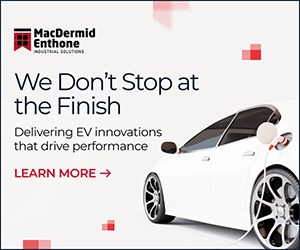When James Burriss sees the delivery trucks backing up receiving at CRC Surface Technologies in central Phoenix, he knows the excitement is about to start.
“Every day is like Christmas morning,” says the president and CEO of the surface technology company, which who provides chemical processing services to the the aerospace, defense, medical, semiconductor/electronics and heavy equipment industries.
“At times, we don’t know what our customers will be sending us so it’s like opening presents under the tree,” adds Burriss, who says the 65-year-old company is the largest special processing facility in Arizona.
ChemResearch Corporation (CRC) offers over 33 special processing services, including anodize, cadmium plating, chem-film, hard chrome plating, coatings/paint, copper plating, Dow 7, electroless nickel plating, grinding, sulfamate & zinc nickel plating, nital etch, non-destructive testing, passivate, manganese and zinc phosphate, silver plating and more.
CRC has been a three-time Products Finishing Top Shop, and operates in a 65,000-square- foot processing facility servicing regional and national machine shops, including an impressive list of OEM customers such as Boeing, BAE Systems, Bell Helicopter, Bombardier Aerospace, Eaton, General Electric, Honeywell, Hamilton Sundstrand, Goodrich, Moog, Northrop Grumann, Parker Aerospace, Pacific Scientific, Rolls Royce, Spirit AeroSystems, Triumph Group, Woodward, just to name a few.
“We’re about 95 percent aerospace and defense,” Burriss says. “We’ve done some heavy equipment and semi-conductor work in support of Arizona’s mining and growing electronics industry, but aerospace and defense is our core business.”
CRC houses probably one of the largest hard chrome systems in the Southwest, equaling eight 1,000 gallon chrome processing tanks, as well as a new type II and III anodize line with 45 processing tanks that support two type II sulfuric and one type III hard sulfuric anodize tanks. They recently cleared out a production bay of over 2,000 square feet of vacant processing capacity for a to-be-determined process.
The facility supports various defense programs ranging from the Apache helicopter to Raytheon’s SM-3 missile. CRC recently installed a semi-automatic passivation type II and VI line to support the assembly of strap packs.
Management Changes
CRC is in its seventh decade, but Burriss just celebrated his 11th anniversary with the company and is coming up on his fifth year as president and CEO. With a strong background in the printing and packaging industry, Burriss joined the company in 2008 to develop the human resources department and assist operations in measuring performance including the development of CRC’s corporate scorecard. Shortly thereafter, Richard Burge, the preceding president, recognized Burriss’ talents and work ethic by putting him in charge of the sales team, where he brought significant value to the organization by modernizing CRC’s sales process and manufacturing execution system.
In July of 2014, things changed when Burge passed away after a three year battle with amyotrophic lateral sclerosis, resulting in leadership uncertainty and a tipping balance sheet. During that time, CRC was down to a couple payroll cycles in the bank and had a legacy environmental problem caused by the original ownership’s poor corporate citizenship and passive approach. Shortly after Burge’s passing, the executive team was reduced, ownership changed and Burriss was appointed as president and CEO.
At the end of the third quarter in 2014, CRC’s debt was nearly 40 percent of our sales, and environmental attorney fees were draining the company’s cash. Burriss says their management practices were not maximizing their available resources, resulting in below-par contribution margins.
“We stopped some of the bleeding by firing the attorneys and worked directly with the state on all things environmental, resulting in a successful remediation and active environmental management system that meets ISO14001 standards,” Burriss says. They upgraded their quality system to AS9100 and deployed a web-based QMS that streamlined document control, procedural training, corrective actions and — more importantly — our continuous improvement initiatives.
“If you want to improve something, measure it,” he says. “AS9100 forces you to do just that.”
CRC wanted to do business like their customers do business, and that change set the tone for raising the bar outlined in their mission statement, which is “to be the premier service provider of metal finishing and integrated services where values-based people are proud to work and succeed.”
“I’m very proud of what we do, but more importantly in our team who at times probably questioned the plan, but remained loyal and did something that others could not,” he says, which included cash flowing a new $1 million anodize line last December and paying off all bank debt.
CRC is AS9100 and Nadcap certified, operates under the Federal Aviation Administration Drug and Alcohol Program, and is compliant under the International Traffic in Arms Regulations (ITAR) protocol, all of which shows they conform to the strictest standards of the aerospace, defense, medical, space and industrial sectors.
“CRC has raised the bar for special process providers by continuously improving performance, and integrating MRO services,” says Eric Liu, Parker Aerospace’s product support director in the fluid systems division. “We consider them an extension of our operation.”
Gaining Certifications and Accreditations
The shop offers anodizing in chromic Type I and sulfuric Type II and III, as well as phosphoric and sealing processes. It’s chem-film processes meet MIL-DTL-5541 specifications for Type I and II, as well as Class 1A and 3. CRC also uses Dow 7 dichromate process, which is a chemical conversion coating that results in no dimensional change to the component, but gets a brassy or dark brown finish (depending on the alloy). It is often a good choice for both new and overhauled parts that have dissimilar materials (such as inserts) or where conditions will tolerate a less robust and less costly alternative to Dow 17 anodizing.
CRC also provides coatings in cadmium, and hard and thin dense chrome for QQ-C-320, BAC5709, MIL-C-20218, ASTM B456, MIL-C-23422 and AMS 2406 specifications. Its sulfamate and zinc nickel and electroless nickel are also in demand, as well as its passivation process for AMS-QQ-P35, ASTM-A-967 and AMS2700 Types II, VI and VIII.
Burriss says that, like any technical industry, a company must constantly develop its personnel or it may find itself short-handed. To combat this issue, CRC deployed the Certified Aerospace Finisher program through the NASF, and recently engaged Arizona’s Department of Economic Security on developing an apprentice program in hopes to grow the next generation of process operators.
Numerous Top Shops Awards
Those measurement practices became handy when Burriss took part in the Products Finishing Top Shops Benchmarking Survey to see where CRC stood against others in the industry.
“When we saw the survey questions, we quickly realized that they mirrored our scorecard,” he says. “It really gave us an opportunity to see how we lined up against other operations around the country. It brought out the accountability that we needed and forced our excellence value, so we felt it was a terrific program to be a part of.”
CRC offers value-added services, such as abrasive and nonabrasive blasting, light assembly, embrittlement relief, precision masking, packaging, part marking with silk screen and stamp, prototype finishing, source inspection, tooling fabrication and vapor degreasing. Those value-added services have attracted a lot of business for the facility.
“Since I’ve started working with CRC, I think we’ve expanded our business with them 10 fold,” says James Racinowski, who is a production scheduler for R&D Manco. “They are one of our top vendors and most trusted.”
During the first few years of his presidency at CRC, Burriss was just trying to right the ship and to get best practices into place. Now, the company is seeing the fruits of dealing with those issues head on and settling in as one of the best surface finishing operations in the U.S.
“As an organization, we have extremely high principals in the way we do business, and we also have a philosophy of always putting money back into the business,” he says. “We worked so hard over the past four years fixing things and getting them corrected, that now is the time to have fun and grow the business.”
Last year was the CRC’s best year ever, from both a job shop sales and profitability perspective.
“This year, our team is absolutely crushing it,” he says.
Visit chemresearchco.com.
Related Content
How to Maximize Nickel Plating Performance
The advantages of boric acid-free nickel plating include allowing manufacturers who utilize nickel plating to keep up the ever-changing regulatory policies and support sustainability efforts.
Read MoreAutomated Electroplating Systems
Simultaneous engineering reduces energy and resource consumption.
Read MoreNickel Electroplating
Applications, plating solutions, brighteners, good operating practices and troubleshooting.
Read MoreHow to Choose Between Sulfate and Chloride-Based Trivalent Chromium
There are several factors to consider when choosing between sulfate and chloride-based baths for trivalent chromium plating. Mark Schario of Columbia Chemical discusses the differences and what platers should keep in mind when evaluating options.
Read MoreRead Next
The 2024 Ford Mustang: All the Colors Available
Although Chevrolet has announced the end of the Camaro and Dodge is offering “Last Call” editions of the Charger and Challenger, the Ford Mustang is launching to its seventh generation.
Read MorePowder Coating 4.0: Smarter, Faster, More Efficient and Connected
New tools reduce cost and waste, lower manufacturing footprint of powder coating operations.
Read MoreEpisode 42: An Interview with Robin Deal, Hubbard-Hall
Hubbard-Hall wastewater treatment specialist Robin Deal discusses the latest trends in wastewater management.
Read More






























